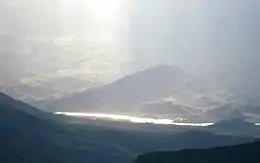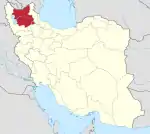Dizmar-e Sharqi Rural District
Dizmar-e Sharqi Rural District (Persian: دهستان ديزمار شرقي)[3] is in Minjavan District of Khoda Afarin County, East Azerbaijan province, Iran.
Dizmar-e Sharqi Rural District
Persian: دهستان ديزمار شرقي | |
|---|---|
 The landmark plain tree in Kavanaq village | |
 Dizmar-e Sharqi Rural District | |
| Coordinates: 38°49′52″N 46°33′32″E[1] | |
| Country | |
| Province | East Azerbaijan |
| County | Khoda Afarin |
| District | Minjavan |
| Population (2016)[2] | |
| • Total | 2,760 |
| Time zone | UTC+3:30 (IRST) |

At the National Census of 2006, its population was 2,888 in 641 households.[4] There were 3,097 inhabitants in 865 households at the following census of 2011.[5] At the most recent census of 2016, the population of the rural district was 2,760 in 867 households. The largest of its 22 villages was Marzabad, with 742 people.[2]
History
Dizmar was first mentioned by the renowned historian Hamdallah Mustawfi in the mid-fourteenth century, "Dizmar is a district in the north of Tabriz which includes more than 50 villages ..." [6] Mardanaqom, was also mentioned by Hamdallah Mustawfi as a thriving village.[6][7] The landmark, manifesting ancient history of the district, is an ancient plane tree in Kavanaq village (included on the map). The tree is about 3 meter in diameter and is said to have lived for 500 years. Moreover, on a mountain between Kavanaq and Mardanaqom, there is a castle dating from Sasanian era. It was used as a jail for high-ranking officials during Khwarazmian reign.[8]
In the wake of White Revolution (early 1960s) many clans of Qarāca Dāġ tribes used Dizmar as their winter quarters.[9] The eastern part of Dizmar was declared a part of Khoda Afarin County in 2011[10] and Mardanaqom was designated as its capital.
References
- OpenStreetMap contributors (3 April 2023). "Dizmar-e Sharqi Rural District (Khoda Afarin County)" (Map). OpenStreetMap. Retrieved 3 April 2023.
- "Census of the Islamic Republic of Iran, 1395 (2016)". AMAR (in Persian). The Statistical Center of Iran. p. 03. Archived from the original (Excel) on 13 November 2020. Retrieved 19 December 2022.
- Iranian National Committee for Standardization of Geographical Names website (in Persian)
- "Census of the Islamic Republic of Iran, 1385 (2006)". AMAR (in Persian). The Statistical Center of Iran. p. 03. Archived from the original (Excel) on 20 September 2011. Retrieved 25 September 2022.
- "Census of the Islamic Republic of Iran, 1390 (2011)" (Excel). Iran Data Portal (in Persian). The Statistical Center of Iran. p. 03. Retrieved 19 December 2022.
- نزهةالقلوب ، حمداله مستوفی ، به کوشش محمد دبیر سیاقی ، انتشارات کتابخانه طهوری ، چاپ اول ، تهران ، ۱۳۳۶، ص. ۱۰۱.
- نزهةالقلوب ، حمداله مستوفی ، به کوشش محمد دبیر سیاقی ، انتشارات کتابخانه طهوری ، چاپ اول ، تهران ، ۱۳۳۶، ص. ۹۶.
- Mohammadi, Vahid. "Mardanaqom Castle". Archived from the original on 14 March 2014. Retrieved 16 March 2014.
- P. Oberling, “The Tribes of Qarāca Dāġ,” Oriens 17, 1964, p. 60-95
- "The government information base was created in Khodaafrin county in East Azarbaijan province" (in Persian). Archived from the original on 6 March 2014. Retrieved 18 February 2023.
